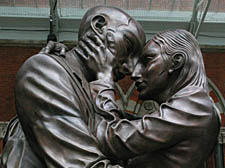|
|
 |
| |
Kitsch criticism stung the sculptor
His artistic backdrop for the new St Pancras came in for some stick, but Paul Day urges critics to wait until it’s finished, writes Gerald Isaaman
A DEFIANT Paul Day cries: “It’s not complete yet!” And his protest comes amid the complaint of “kitsch” that has been hurled at his monumental sculpture of an embracing couple that now adorns the St Pancras International Station as a star attraction in its own right.
Million-pound kitsch too, as that is the overall cost of the huge bronze sculpture weighing five tonnes that stands supreme alongside the great Barlow engine shed that creates the architectural impact of the Victorian station, now Britain’s Eurostar heartbeat terminus.
It was opened last month by the Queen after a revamp costing a mighty £800 million.
Indeed, it is the very scale of the injection of life back into Sir George Gilbert Scott’s Gothic-fronted station that has brought it back into contention – one of the vital aspects for the 40-year-old sculptor being the fact that his work is not over.
It was only in October last year that he saw St Pancras Station for the first time in his life, being one of a number of artists invited to come up with ideas for a public work of art. He produced three sketches virtually on the spot and, to his own amazement, rapidly became the unanimously chosen candidate by the London and Continental Railways selection panel without any formal competition taking place.
All concerned were aware too that the time allowed for completion was beyond the realms of any foundry, the more so since Paul’s design – once his maquettes, prepared over three months, were approved – incorporates a huge frieze, which he is still working on and will probably not be in situ until late next year.
“From the beginning I designed a relief as a magnet for the sculpture, like a ribbon running continuously all the way round the base of the sculpture,” he explains. “It would look at a multitude of things, first and foremost being concerned with train travel as we live and know it today.
“But it will also have a strong element of people departing and meeting and the gamut of emotions experienced when leaving loved ones for a long time or travelling alone and being in the close proximity of strangers.
“I have always found travel in that way, particularly on trains, is an extremely fertile source of inspiration anyway, and I thought the reliefs would have interesting flashbacks, some little vignettes looking back at the life of the station with some steam in there too.
“So this work is as yet incomplete. The relief around the base will make an enormous difference to how people will experience it, creating a great deal of interest and thought about the embracing couple. They are the signpost statement of the sculpture, bridging the scale between the individual and the vastness of the station.”
His attention to detail is immaculate. So to be told, notably by Stephen Bayley in The Guardian, that his sculpture was pure kitsch both baffled and upset him, the more so as he believes that modern art has totally lost touch with figurative images and is unable to express human emotions.
His 25-metre-long Battle of Britain relief sculpture on the Victoria Embankment has earned him enormous praise, so much so that he is working on a royal commission for two relief panels for the plinth of Philip Jackson’s statue of the late Queen Mother, due to be unveiled in The Mall next year.
“Bayley says that when art has lost its anger you are left with a corpse which is kitsch,” Paul recalls. “That’s his definition of kitsch – art without anger. First of all, I would say that the anger needed to make art does not necessarily make angry art.
“What one requires is not just anger but love, commitment, dedication and discipline. And my St Pancras sculpture is a loving image. Art has to touch the heart and get to the emotions. And there has to be a physical shock, a sense of wow, of wonder and awe in some way. To me, art is fundamentally about appealing to that mysterious, difficult to define sense of beauty that pervades cultures and all human civilisation.
“People think that artists have just given up on beauty and on composition and on the desire to express the simpler and more universal emotions that we experience in favour of media-driven and technocratic art which is self-referential.”
Day also believes that art should stimulate debate, and the controversy has benefited his work, though not harmed his reputation, because he claims he doesn’t have one and has never received negative responses to his work in the past.
Living with his half-French wife and two children near Dijon, in France, also keeps him out of the limelight and out of touch with the public prints.
Nevertheless, he found the harsh criticism “a little hurtful”, partly because he doesn’t understand its fundamental basis, and adds: “I am a sensitive creature and, I suppose, initially the criticism did affect me.
Day has little need for concern given the acclaim St Pancras has brought him – and the new commissions too.
“My work for St Pancras has been a big positive for me,” he muses.
“That it has divided opinion is inevitable – because it is not a block of concrete with a few scratchings on it, like the art housed in most international at museums at the moment.
“It is very different – and that difference will be a breath of fresh air for many people who just assume that contemporary art has to be elitist and incomprehensible.” |

|
 |
|
 |
|

